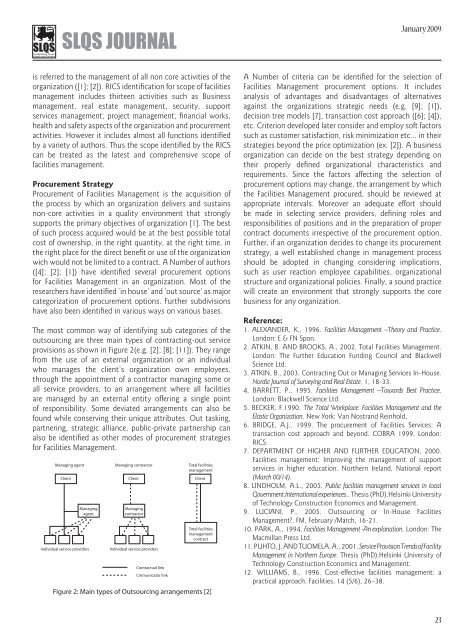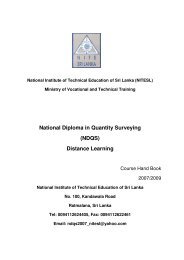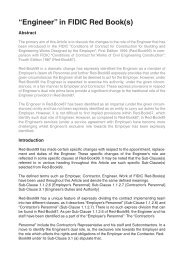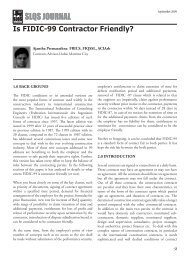SLQS-Journal Vol. 1 - Slqs-uae.org
SLQS-Journal Vol. 1 - Slqs-uae.org
SLQS-Journal Vol. 1 - Slqs-uae.org
Create successful ePaper yourself
Turn your PDF publications into a flip-book with our unique Google optimized e-Paper software.
<strong>SLQS</strong> JOURNALJanuary 2009is referred to the management of all non core activities of the<strong>org</strong>anization ([1]; [2]). RICS identification for scope of facilitiesmanagement includes thirteen activities such as Businessmanagement, real estate management, security, supportservices management, project management, financial works,health and safety aspects of the <strong>org</strong>anization and procurementactivities. However it includes almost all functions identifiedby a variety of authors. Thus the scope identified by the RICScan be treated as the latest and comprehensive scope offacilities management.Procurement StrategyProcurement of Facilities Management is the acquisition ofthe process by which an <strong>org</strong>anization delivers and sustainsnon-core activities in a quality environment that stronglysupports the primary objectives of <strong>org</strong>anization [1]. The bestof such process acquired would be at the best possible totalcost of ownership, in the right quantity, at the right time, inthe right place for the direct benefit or use of the <strong>org</strong>anizationwich would not be limited to a contract. A Number of authors([4]; [2]; [1]) have identified several procurement optionsfor Facilities Management in an <strong>org</strong>anization. Most of theresearchers have identified ‘in house’ and ‘out source’ as majorcategorization of procurement options. Further subdivisionshave also been identified in various ways on various bases.The most common way of identifying sub categories of theoutsourcing are three main types of contracting-out serviceprovisions as shown in Figure 2(e.g. [2]; [8]; [11]). They rangefrom the use of an external <strong>org</strong>anization or an individualwho manages the client’s <strong>org</strong>anization own employees,through the appointment of a contractor managing some orall service providers, to an arrangement where all facilitiesare managed by an external entity offering a single pointof responsibility. Some deviated arrangements can also befound while conserving their unique attributes. Out tasking,partnering, strategic alliance, public-private partnership canalso be identified as other modes of procurement strategiesfor Facilities Management.Managing agentClient Client ClientManagingagentIndividual service providersManaging contractorManagingcontractorIndividual service providersContractual linkCmmunicator linkTotal facilitiesmanagementTotal facilitiesmanagementcontractFigure 2: Main types of Outsourcing arrangements [2]A Number of criteria can be identified for the selection ofFacilities Management procurement options. It includesanalysis of advantages and disadvantages of alternativesagainst the <strong>org</strong>anizations strategic needs (e.g. [9]; [1]),decision tree models [7], transaction cost approach ([6]; [4]),etc. Criterion developed later consider and employ soft factorssuch as customer satisfaction, risk minimization etc... in theirstrategies beyond the price optimization (ex. [2]). A business<strong>org</strong>anization can decide on the best strategy depending ontheir properly defined <strong>org</strong>anizational characteristics andrequirements. Since the factors affecting the selection ofprocurement options may change, the arrangement by whichthe Facilities Management procured, should be reviewed atappropriate intervals. Moreover an adequate effort shouldbe made in selecting service providers, defining roles andresponsibilities of positions and in the preparation of propercontract documents irrespective of the procurement option.Further, if an <strong>org</strong>anization decides to change its procurementstrategy, a well established change in management processshould be adopted in changing considering implications,such as user reaction employee capabilities, <strong>org</strong>anizationalstructure and <strong>org</strong>anizational policies. Finally, a sound practicewill create an environment that strongly supports the corebusiness for any <strong>org</strong>anization.Reference:1. ALEXANDER, K., 1996. Facilities Management –Theory and Practice.London: E & FN Spon.2. ATKIN, B. AND BROOKS, A., 2002. Total Facilities Management.London: The Further Education Funding Council and BlackwellScience Ltd.3. ATKIN, B., 2003. Contracting Out or Managing Services In-House.Nordic <strong>Journal</strong> of Surveying and Real Estate, 1, 18-33.4. BARRETT, P., 1995. Facilities Management –Towards Best Practice.London: Blackwell Science Ltd.5. BECKER, F.1990. The Total Workplace: Facilities Management and theElastic Organization. New York: Van Nostrand Reinhold.6. BRIDGE, A.J., 1999. The procurement of Facilities Services: Atransaction cost approach and beyond. COBRA 1999, London:RICS.7. DEPARTMENT OF HIGHER AND FURTHER EDUCATION, 2000.Facilities management: Improving the management of supportservices in higher education. Northern Ireland, National report(March 00/14).8. LINDHOLM, A.L., 2005. Public facilities management services in localGovernment:International experiences.. Thesis (PhD).Helsinki Universityof Technology Construction Economics and Management.9. LUCIANI, P., 2005. Outsourcing or In-House FacilitiesManagement?. FM, February /March, 16-21.10. PARK, A., 1994. Facilities Management -An explanation. London: TheMacmillan Press Ltd.11. PUHTO, J. AND TUOMELA, A., 2001. Service Provision Trends of FacilityManagement in Northern Europe. Thesis (PhD).Helsinki University ofTechnology Construction Economics and Management.12. WILLIAMS, B., 1996. Cost-effective facilities management: apractical approach. Facilities, 14 (5/6), 26–38.23





